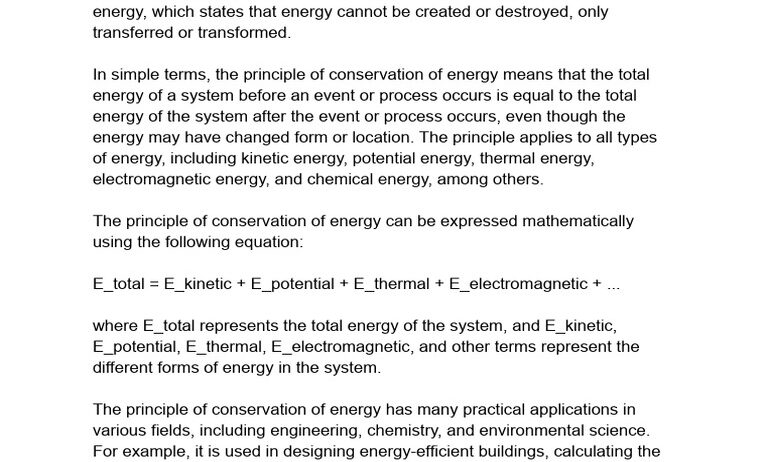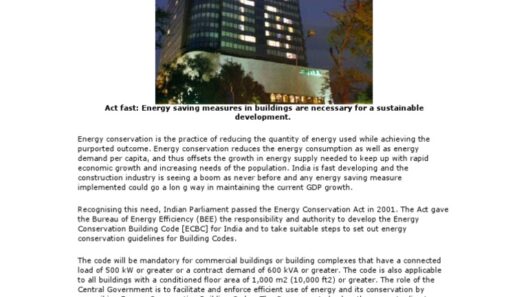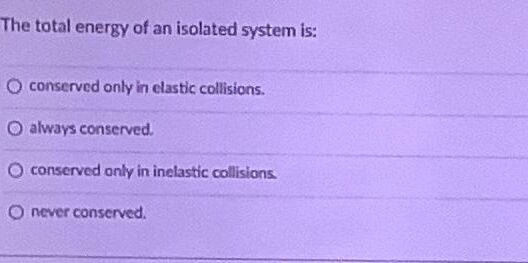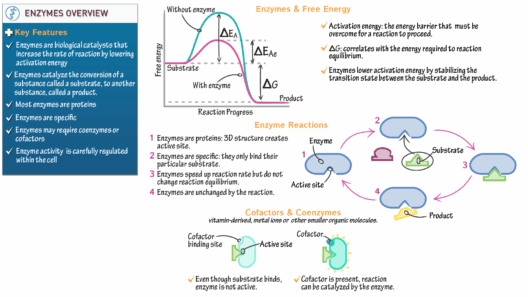The principle of conservation of energy is a fundamental concept in physics that asserts that the total energy within a closed system remains constant over time. This crucial tenet reveals the intrinsic relationship between energy forms and the profound implications of energy transformation. Recognizing this principle rewrites our understanding of not only the natural sciences but also presents a philosophical paradigm: energy cannot be created or destroyed, merely converted from one form to another. Understanding this principle shapes our perception of the world and challenges us to rethink our human impact on the environment.
In elementary terms, energy is the capacity to do work. It manifests in various forms—kinetic, potential, thermal, chemical, and nuclear energy, among others. Each form can transition to another, reminiscent of an elaborate dance. For instance, when a substance combusts, chemical energy relinquishes its form, yielding heat and light. This dynamic interplay extends beyond mere scientific inquiry; it prompts essential discussions surrounding sustainable practices and environmental stewardship. By recognizing the conservation of energy, one grasps the importance of harnessing energy resources judiciously and the need for innovative approaches to minimize waste.
The historical inception of the conservation principle can be traced back to early scientific endeavors. Notably, in the 19th century, physicist Julius Robert von Mayer articulated the principle in the context of thermodynamics. Mayer’s work demonstrated that energy changes in one form will equal changes in another. His insights established a foundational framework in understanding energy dynamics in physical and chemical processes, heralding a new era of scientific exploration and inquiry.
One of the compelling aspects of this principle is the reliance on the concept of closed systems. In an isolated or closed system, energy can circulate but cannot escape. For example, the heat generated in an insulated container by a boiling kettle will remain within that system, oscillating between kinetic and thermal forms. This understanding lays the groundwork for broader discussions about energy consumption and waste in modern societies. In a world characterized by rampant consumption and energy depletion, recognizing the finite nature of resources is imperative.
Moreover, the conservation of energy is intrinsically tied to the second law of thermodynamics, which asserts that energy transformations are not 100% efficient. In every energy conversion, some energy disperses into less useful forms, typically as waste heat. This inevitable loss raises an urgent concern: how can society reconcile its aspirations for growth with the principles of energy conservation? The challenge looms larger as the global population expands and the demand for energy escalates, prompting a necessary shift towards renewable energy sources.
Renewable energy sources manifest as potent allies in the quest for sustainable living. Harnessing solar, wind, hydropower, and geothermal energy encapsulates the essence of energy conservation. By leveraging these inexhaustible resources, we can diminish our reliance on fossil fuels, ultimately curtailing greenhouse gas emissions. The integration of these types of energy into the energy mix symbolizes a paradigm shift in perspective, emphasizing the significance of harmony with nature rather than exploitation.
Another crucial aspect surrounding the principle of conservation of energy can be observed in energy efficiency and technological advancements. Innovations have led to the development of energy-efficient appliances, hybrid vehicles, and smart grids that optimize energy consumption patterns. These evolved technologies translate to reduced energy waste, ultimately propelling societies toward a more sustainable future. As advances in technology continue to unfold, the collaboration between science and engineering can indeed beckon profound changes in energy applications, from domestic usage to industrial production.
Engineering breakthroughs manifest in myriad ways. Consider the potential of energy storage systems, such as advanced batteries or flywheels. These technologies can capture surplus energy generated during peak renewable generation periods, releasing it during times of high demand. They act as vital instruments in reconciling the intermittent nature of renewable resources with continuous consumption, thereby enhancing energy reliability. As societies strive toward reducing their carbon footprints, understanding and implementing the conservation of energy remains paramount.
Additionally, the conservation principle prompts an exploration into social and economic ramifications. The energy sector employs vast numbers of individuals, intertwining economic strength with energy production and sustainability. Transitioning to renewable energy sources holds the promise of job creation while simultaneously decreasing the reliance on non-renewable resources. This presents an exciting opportunity for education and training programs aimed at equipping the workforce with essential skills for a greener economy. Investing in human capital will not only aid in the transition but also inspire a collective responsibility towards the environment.
In conclusion, the principle of conservation of energy transcends mere scientific theory; it encapsulates a profound wisdom that calls for a shift in perspective, urging humanity to recognize its role within a broader ecological framework. Embracing this principle has consequential implications, driving us toward sustainable practices, advancing technology, and fostering economic growth through innovation. By comprehending the multifaceted nature of energy transformation, societies can cultivate a more responsible, mindful, and sustainable future, ensuring that the delicate balance of our planet is not only preserved but revered.







